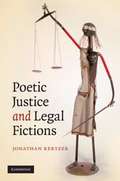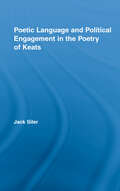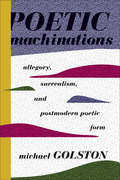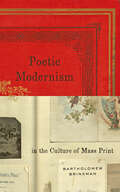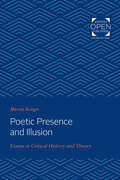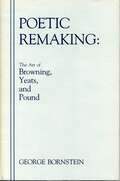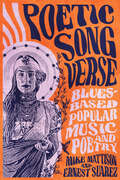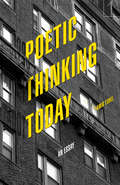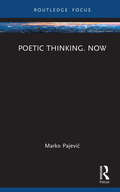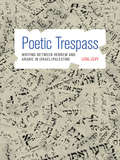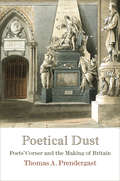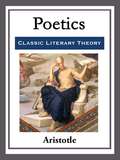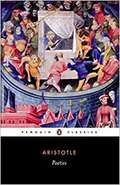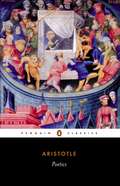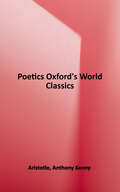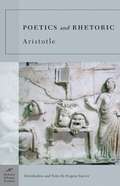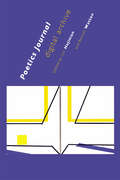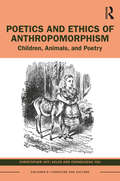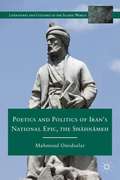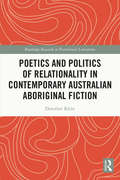- Table View
- List View
Poetic Justice and Legal Fictions
by Jonathan KertzerLiterature reveals the intense efforts of moral imagination required to articulate what justice is and how it might be satisfied. Examining a wide variety of texts including Shakespeare's plays, Gilbert and Sullivan's operas, and modernist poetics, Poetic Justice and Legal Fictions explores how literary laws and values illuminate and challenge the jurisdiction of justice and the law. Jonathan Kertzer examines how justice is articulated by its command of, or submission to, time, nature, singularity, truth, transcendence and sacrifice, marking the distance between the promise of justice to satisfy our moral and sociable needs and its failure to do so. Poetic Justice and Legal Fictions will be invaluable reading for scholars of the law within literature and amongst modernist and twentieth century literature specialists.
Poetic Language and Political Engagement in the Poetry of Keats (Studies in Major Literary Authors)
by Jack L. SilerIn this incisive volume Siler traces the uneasy relationship between the content of Keats' poems and social history. In the process, he discovers that the early poems are linked with the mission statement of the radical journal Annals of the Fine Arts, whilst the poems after Endymion reveal a poet more concerned with the nature of poetic representation--its why and wherefore.
Poetic Logic and the Origins of the Mathematical Imagination (Mathematics in Mind)
by Marcel DanesiThis book treats eighteenth-century Italian philosopher Giambattista Vico’s theory of poetic logic for the first time as the originating force in mathematics, transforming instinctive counting and spatial perception into poetic (metaphorical) symbolism that dovetails with the origin of language. It looks at current work on mathematical cognition (from Lakoff and Núñez to Butterworth, Dehaene, and beyond), matching it against the poetic logic paradigm. In a sense, it continues from where Kasner and Newman left off, connecting contemporary research on the mathematical mind to the idea that the products of early mathematics were virtually identical to the first forms of poetic language. As such, this book informs the current research on mathematical cognition from a different angle, by looking back at a still relatively unknown philosopher within mathematics.The aim of this volume is to look broadly at what constitutes the mathematical mind through the Vichian lens of poetic logic. Vico was among the first to suggest that the essential nature of mind could be unraveled indirectly by reconstructing the sources of its “modifications” (his term for “creations”); that is, by examining the creation and function of symbols, words, and all the other uniquely human artifacts—including mathematics—the mind has allowed humans to establish “the world of civil society,” Vico’s term for culture and civilization.The book is of interest to cognitive scientists working on math cognition. It presents the theory of poetic logic as Vico articulated it in his book The New Science, examining its main premises and then applying it to an interpretation of the ongoing work in math cognition. It will also be of interest to the general public, since it presents a history of early mathematics through the lens of an idea that has borne fruit in understanding the origin of language and symbols more broadly.
Poetic Machinations
by Michael GolstonThe shape, lineation, and prosody of postmodern poems are extravagantly inventive, imbuing their form with as much meaning as their content. Through a survey of American poetry and poetics from the end of World War II to the present, Michael Golston traces the proliferation of these experiments to a growing fascination with allegory in philosophy, linguistics, critical theory, and aesthetics, introducing new strategies for reading American poetry while embedding its formal innovations within the history of intellectual thought.Beginning with Walter Benjamin's explicit understanding of Surrealism as an allegorical art, Golston defines a distinct engagement with allegory among philosophers, theorists, and critics from 1950 to today. Reading Fredric Jameson, Angus Fletcher, Roland Barthes, and Craig Owens, and working with the semiotics of Charles Sanders Pierce, Golston develops a theory of allegory he then applies to the poems of Louis Zukofsky and Lorine Niedecker, who, he argues, wrote in response to the Surrealists; the poems of John Ashbery and Clark Coolidge, who incorporated formal aspects of filmmaking and photography into their work; the groundbreaking configurations of P. Inman, Lyn Hejinian, Myung Mi Kim, and the Language poets; Susan Howe's "Pierce-Arrow," which he submits to semiotic analysis; and the innovations of Craig Dworkin and the conceptualists. Revitalizing what many consider to be a staid rhetorical trope, Golston positions allegory as a creative catalyst behind postwar American poetry's avant-garde achievements.
Poetic Machinations: Allegory, Surrealism, and Postmodern Poetic Form
by Michael GolstonThe shape, lineation, and prosody of postmodern poems are extravagantly inventive, imbuing both form and content with meaning. Through a survey of American poetry and poetics from the end of World War II to the present, Michael Golston traces the proliferation of these experiments to a growing fascination with allegory in philosophy, linguistics, critical theory, and aesthetics, introducing new strategies for reading American poetry while embedding its formal innovations within the history of intellectual thought.Beginning with Walter Benjamin's explicit understanding of Surrealism as an allegorical art, Golston defines a distinct engagement with allegory among philosophers, theorists, and critics from 1950 to today. Reading Fredric Jameson, Angus Fletcher, Roland Barthes, and Craig Owens, and working with the semiotics of Charles Sanders Pierce, Golston develops a theory of allegory he then applies to the poems of Louis Zukofsky and Lorine Niedecker, who, he argues, wrote in response to the Surrealists; the poems of John Ashbery and Clark Coolidge, who incorporated formal aspects of filmmaking and photography into their work; the groundbreaking configurations of P. Inman, Lyn Hejinian, Myung Mi Kim, and the Language poets; Susan Howe's "Pierce-Arrow," which he submits to semiotic analysis; and the innovations of Craig Dworkin and the conceptualists. Revitalizing what many consider to be a staid rhetorical trope, Golston positions allegory as a creative catalyst behind American poetry's postwar avant-garde achievements.
Poetic Modernism in the Culture of Mass Print (Hopkins Studies in Modernism)
by Bartholomew BrinkmanHow scrapbooking, book collecting, and other ways of handling print media informed modernist poetry.In Poetic Modernism in the Culture of Mass Print, Bartholomew Brinkman argues that an emerging mass print culture conditioned the production, reception, and institutionalization of poetic modernism from the latter part of the nineteenth century through the middle of the twentieth century—with lasting implications for the poetry and media landscape. Drawing upon extensive archival research in the United States and Britain, Brinkman demonstrates that a variety of print collecting practices—including the anthology, the periodical, the collage poem, volumes of selected and collected poems, and the modern poetry archive—helped structure key formal and institutional sites of poetic modernism. Brinkman focuses on the generative role of book collecting practices and the negotiation of print ephemera in scrapbooks. He also traces the evolution of the modern poetry archive as a particular case of the mid-twentieth-century rise of literary archives and identifies parallels between the beginning of mass print culture at the end of the nineteenth century and the growth of digital culture today. Advocating for a transatlantic modernism that stretches roughly from 1880 to 1960—one that incorporates both popular and canonical poets—Brinkman successfully extends the geographical, historical, and vertical dimensions of modernist studies. Poetic Modernism in the Culture of Mass Print will appeal not only to scholars and students of literary modernism, modern periodical studies, book history, print culture, media studies, history, art history, and museum studies but also to librarians, archivists, museum curators, and information science professionals.
Poetic Presence and Illusion: Essays in Critical History and Theory
by Murray KriegerOrignally published in 1979. Poetic Presence and Illusion brings together Krieger's speculation on literature and its effect on the reader. The poem, Krieger argues, is an illusionary presence and an ever-present illusion. It exists for the reader, like a drama before an audience, only within an illusionary context. But the illusion should not be taken lightly as a false substitute for reality. It is itself a real and positive force: it is what we see and, as such, is constitutive of our reality, even if our critical faculty de-constitutes that reality by viewing it as no more than an illusion. The coupling of poetic presence and poetic illusion serves to describe the relationship between poetry as metaphor and the reader's sense of personal and poetic reality. Krieger examines the workings of selected Renaissance and contemporary poems with regard to this dual nature and evaluates the work of literary critics (himself included) who have been concerned with this doubleness. Poetic Presence and Illusion allows readers who have read Krieger's earlier work to understand the development of his critical position.
Poetic Remaking: The Art of Browning, Yeats, and Pound
by George BornsteinThis volume offers a coherent view of post-romantic poetic development through selective examples both of individual poems and of poetic influence. Bornstein focuses most centrally on Browning in the Victorian period and Yeats and Pound in the Modern, but also looks more briefly at works by Wordsworth, Coleridge, Keats, Shelley, Arnold, Tennyson, and Eliot. The introductory manifesto, "Four Gaps in Postromantic Influence Study," posits four new orientations for such work: taking the volume (rather than the individual poem) as a unit; stressing more centrally the Victorian mediation between Romantic and Modern; allowing for national differences among English, Irish, and American traditions; and basing influence studies as much on manuscript materials as on finished products. Each of the following chapters follows one or more of those orientations.The initial four chapters, "Remaking Poetry," focus on readings of specific poetic texts. The first treats Browning's first major volume as a unit; the second reads his dramatic monologue "Pictor Ignotus" against Romantic acts of mind; the third maps distinctively Victorian variations in the major form known as Greater Romantic Lyric; and the fourth explores Yeats's mature revision of that form. The second group of four chapters, "Remaking Poets," stresses the dynamics of literary influence by which poets turn their forerunners into figures helpful to their own development. The first three examine Yeats's encounter with Dante, Spenser, Browning, and Tennyson, respectively; the fourth treats Pound's remaking of the poet he called his poetic "father," Browning, in a way that suggests the limits of anxiety models of poetic influence.For this volume Professor Bornstein has revised and expanded a select group of his recent essays and added a new one, on the Greater Victorian Lyric.
Poetic Remaking: The Art of Browning, Yeats, and Pound
by George BornsteinThis volume offers a coherent view of post-romantic poetic development through selective examples both of individual poems and of poetic influence. Bornstein focuses most centrally on Browning in the Victorian period and Yeats and Pound in the Modern, but also looks more briefly at works by Wordsworth, Coleridge, Keats, Shelley, Arnold, Tennyson, and Eliot. The introductory manifesto, "Four Gaps in Postromantic Influence Study," posits four new orientations for such work: taking the volume (rather than the individual poem) as a unit; stressing more centrally the Victorian mediation between Romantic and Modern; allowing for national differences among English, Irish, and American traditions; and basing influence studies as much on manuscript materials as on finished products. Each of the following chapters follows one or more of those orientations.The initial four chapters, "Remaking Poetry," focus on readings of specific poetic texts. The first treats Browning's first major volume as a unit; the second reads his dramatic monologue "Pictor Ignotus" against Romantic acts of mind; the third maps distinctively Victorian variations in the major form known as Greater Romantic Lyric; and the fourth explores Yeats's mature revision of that form. The second group of four chapters, "Remaking Poets," stresses the dynamics of literary influence by which poets turn their forerunners into figures helpful to their own development. The first three examine Yeats's encounter with Dante, Spenser, Browning, and Tennyson, respectively; the fourth treats Pound's remaking of the poet he called his poetic "father," Browning, in a way that suggests the limits of anxiety models of poetic influence.For this volume Professor Bornstein has revised and expanded a select group of his recent essays and added a new one, on the Greater Victorian Lyric.
Poetic Revelations: Word Made Flesh Made Word: The Power of the Word III (The Power of the Word)
by Mark S. Burrows Jean Ward Małgorzata GrzegorzewskaThis book explores the much debated relation of language and bodily experience (i.e. the 'flesh'), considering in particular how poetry functions as revelatory discourse and thus relates to the formal horizon of theological inquiry. The central thematic focus is around a 'phenomenology of the flesh' as that which connects us with the world, being the site of perception and feeling, joy and suffering, and of life itself in all its vulnerability. <P><P> The voices represented in this collection reflect interdisciplinary methods of interpretation and broadly ecumenical sensibilities, focusing attention on such matters as the revelatory nature of language in general and poetic language in particular, the function of poetry in society, the question of Incarnation and its relation to language and the poetic arts, the kenosis of the Word, and human embodiment in relation to the word 'enfleshed' in poetry.
Poetic Song Verse: Blues-Based Popular Music and Poetry
by Ernest Suarez Mike MattisonPoetic Song Verse: Blues-Based Popular Music and Poetry invokes and critiques the relationship between blues-based popular music and poetry in the twentieth and twenty-first centuries. The volume is anchored in music from the 1960s, when a concentration of artists transformed modes of popular music from entertainment to art-that-entertains. Musician Mike Mattison and literary historian Ernest Suarez synthesize a wide range of writing about blues and rock—biographies, histories, articles in popular magazines, personal reminiscences, and a selective smattering of academic studies—to examine the development of a relatively new literary genre dubbed by the authors as “poetic song verse.” They argue that poetic song verse was nurtured in the fifties and early sixties by the blues and in Beat coffee houses, and matured in the mid-to-late sixties in the art of Bob Dylan, the Beatles, the Rolling Stones, the Doors, Jimi Hendrix, Joni Mitchell, Leonard Cohen, Gil Scott-Heron, Van Morrison, and others who used voice, instrumentation, arrangement, and production to foreground semantically textured, often allusive, and evocative lyrics that resembled and engaged poetry. Among the questions asked in Poetic Song Verse are: What, exactly, is this new genre? What were its origins? And how has it developed? How do we study and assess it? To answer these questions, Mattison and Suarez engage in an extended discussion of the roots of the relationship between blues-based music and poetry and address how it developed into a distinct literary genre. Unlocking the combination of richly textured lyrics wedded to recorded music reveals a dynamism at the core of poetic song verse that can often go unrealized in what often has been considered merely popular entertainment. This volume balances historical details and analysis of particular songs with accessibility to create a lively, intelligent, and cohesive narrative that provides scholars, teachers, students, music influencers, and devoted fans with an overarching perspective on the poetic power and blues roots of this new literary genre.
Poetic Thinking Today: An Essay (Square One: First-Order Questions in the Humanities)
by Amir EshelThinking is much broader than what our science-obsessed, utilitarian culture often takes it to be. More than mere problem solving or the methodical comprehension of our personal and natural circumstances, thinking may take the form of a poem, a painting, a sculpture, a museum exhibition, or a documentary film. Exploring a variety of works by contemporary artists and writers who exemplify poetic thinking, this book draws our attention to one of the crucial affordances of this form of creative human insight and wisdom: its capacity to help protect and cultivate human freedom. All the contemporary works of art and literature that Poetic Thinking Today examines touch on our recent experiences with tyranny in culture and politics. They express the uninhibited thoughts and ideas of their creators even as they foster poetic thinking in us. In an era characterized by the global reemergence of authoritarian tendencies, Amir Eshel writes with the future of the humanities in mind. He urges the acknowledgment and cultivation of poetic thinking as a crucial component of our intellectual pursuits in general and of our educational systems more specifically.
Poetic Thinking. Now (Routledge Focus on Literature)
by Marko PajevićThis book presents my concept of poetic thinking in the context of debates around the anthropological question, that is ‘what is being human?’, building on ‘thinking language’ and dialogical thinking, developing a poetological anthropology. It evokes political and social issues to demonstrate why poetics is of general relevance for our times. The chapters relate these questions to insights of quantum physics and neurosciences and discuss aspects of contemporary technology, media and medicine, employing notions such as atmospheres, immanent transcendence, silence and presence from contemporary thinkers. Poetic thinking considers the world in its togetherness, offering an alternative to the opposition of subject and object. It demonstrates the transformative power in the interaction of the form of language and the form of life. Poetic thinking takes place when a subject constitutes itself in creative and dialogical language, transforming its ways of feeling and thinking, in short, its way of perceiving the world.
Poetic Trespass
by Lital LevyA Palestinian-Israeli poet declares a new state whose language, "Homelandic," is a combination of Arabic and Hebrew. A Jewish-Israeli author imagines a "language plague" that infects young Hebrew speakers with old world accents, and sends the narrator in search of his Arabic heritage. In Poetic Trespass, Lital Levy brings together such startling visions to offer the first in-depth study of the relationship between Hebrew and Arabic in the literature and culture of Israel/Palestine. More than that, she presents a captivating portrait of the literary imagination's power to transgress political boundaries and transform ideas about language and belonging. Blending history and literature, Poetic Trespass traces the interwoven life of Arabic and Hebrew in Israel/Palestine from the turn of the twentieth century to the present, exposing the two languages' intimate entanglements in contemporary works of prose, poetry, film, and visual art by both Palestinian and Jewish citizens of Israel. In a context where intense political and social pressures work to identify Jews with Hebrew and Palestinians with Arabic, Levy finds writers who have boldly crossed over this divide to create literature in the language of their "other," as well as writers who bring the two languages into dialogue to rewrite them from within. Exploring such acts of poetic trespass, Levy introduces new readings of canonical and lesser-known authors, including Emile Habiby, Hayyim Nahman Bialik, Anton Shammas, Saul Tchernichowsky, Samir Naqqash, Ronit Matalon, Salman Masalha, A. B. Yehoshua, and Almog Behar. By revealing uncommon visions of what it means to write in Arabic and Hebrew, Poetic Trespass will change the way we understand literature and culture in the shadow of the Israeli-Palestinian conflict.Some images inside the book are unavailable due to digital copyright restrictions.
Poetical Dust
by Thomas A. PrendergastIn the South Transept of Westminster Abbey in London, the bodies of more than seventy men and women, primarily writers, poets, and playwrights, are interred, with many more memorialized. From the time of the reburial of Geoffrey Chaucer in 1556, the space has become a sanctuary where some of the most revered figures of English letters are celebrated and remembered. Poets' Corner is now an attraction visited by thousands of tourists each year, but for much of its history it was also the staging ground for an ongoing debate on the nature of British cultural identity and the place of poetry in the larger political landscape.Thomas Prendergast's Poetical Dust offers a provocative, far-reaching, and witty analysis of Poets' Corner. Covering nearly a thousand years of political and literary history, the book examines the chaotic, sometimes fitful process through which Britain has consecrated its poetry and poets. Whether exploring the several burials of Chaucer, the politicking of Alexander Pope, or the absence of William Shakespeare, Prendergast asks us to consider how these relics attest to the vexed, melancholy ties between the literary corpse and corpus. His thoughtful, sophisticated discussion reveals Poets' Corner to be not simply a centuries-old destination for pilgrims and tourists alike but a monument to literary fame and the inevitable decay of the bodies it has both rejected and celebrated.
Poetics
by AristotleAristotle's 'Poetics' is the earliest surviving work of dramatic theory and the first extant philosophical treatise to focus on literary theory.
Poetics
by Aristotle Malcolm HeathIn the Poetics, his near-contemporary account of classical Greek tragedy, Aristotle examine the dramatic elements of plot, character, language and spectacle that combine to produce pity and fear in the audience, and asks why we derive pleasure from this apparently painful process. Taking examples from the plays of Aeschylus, Sophocles and Euripides, the Poetics introduced into literary criticism such central concepts as mimesis ('imitation'), hamartia ('error') and katharsis, which have informed serious thinking about drama ever since. Aristotle explains how the most effective tragedies rely on complication and resolution, recognition and reversals, while centring on chaaracerts of heroic stature, idealised yet true to life. One of the most perceptive and influential works of criticism in Western literary history, the Poetics has informed serious thinking about drama ever since. <p><p> Malcolm Heath's lucid translation makes the Poetics fully accessible to the modern reader. In this edition it is accompanied by an extended introduction, which discusses the key concepts in detail, and includes suggestions for further reading.
Poetics
by AristotleOne of the most powerful, perceptive and influential works of criticism in Western literary history In his near-contemporary account of classical Greek tragedy, Aristotle examines the dramatic elements of plot, character, language and spectacle that combine to produce pity and fear in the audience, and asks why we derive pleasure from this apparently painful process. Taking examples from the plays of Aeschylus, Sophocles and Euripides, the Poetics introduced into literary criticism such central concepts as mimesis ('imitation'), hamartia ('error') and katharsis ('purification'). Aristotle explains how the most effective tragedies rely on complication and resolution, recognition and reversals. The Poetics has informed thinking about drama ever since.Translated with an Introduction and Notes by Malcolm Heath
Poetics (Oxford World's Classics Ser.)
by AristotleAristotle's Poetics is the most influential book on poetry ever written. A founding text of European aesthetics and literary criticism, from it stems much of our modern understanding of the creation and impact of imaginative writing, including poetry, drama, and fiction. <p><p>For Aristotle, the art of representation conveys universal truths that we can appreciate more easily than the lessons of history or philosophy. In his short treatise Aristotle discusses the origins of poetry and its early development, the nature of tragedy and plot, and offers practical advice to playwrights. <p><p>This new translation by Anthony Kenny is accompanied by associated material from Plato and a range of responses from more modern literary practitioners: Sir Philip Sidney, P. B. Shelley, and Dorothy L. Sayers. The book includes a wide-ranging introduction and notes, making this the most accessible and attractive modern edition.
Poetics (SparkNotes Philosophy Guide)
by SparkNotesPoetics (SparkNotes Philosophy Guide) Making the reading experience fun! SparkNotes Philosophy Guides are one-stop guides to the great works of philosophy–masterpieces that stand at the foundations of Western thought. Inside each Philosophy Guide you&’ll find insightful overviews of great philosophical works of the Western world.
Poetics And Rhetoric (Barnes And Noble Classics)
by Aristotle S. H. Butcher George Stade Eugene Garver W. Rhys RobertsPoetics and Rhetoric, by Aristotle, is part of the Barnes & Noble Classics series, which offers quality editions at affordable prices to the student and the general reader, including new scholarship, thoughtful design, and pages of carefully crafted extras. <P><P> Here are some of the remarkable features of Barnes & Noble Classics: New introductions commissioned from today's top writers and scholars Biographies of the authors Chronologies of contemporary historical, biographical, and cultural events Footnotes and endnotes Selective discussions of imitations, parodies, poems, books, plays, paintings, operas, statuary, and films inspired by the work Comments by other famous authors Study questions to challenge the reader's viewpoints and expectations Bibliographies for further reading Indices & Glossaries, when appropriate All editions are beautifully designed and are printed to superior specifications; some include illustrations of historical interest. Barnes & Noble Classics pulls together a constellation of influences--biographical, historical, and literary--to enrich each reader's understanding of these enduring works. <P><P> It is no exaggeration to say that all Western literary criticism flows from Aristotle. In the Poetics he focuses mainly on drama, especially tragedy, and introduces ideas that are still being debated more than two thousand years later. Among them is the often misunderstood theory of the unities of action, place, and time, as well as such concepts as: art as a form of imitation, and drama as an imitation of human actions; plot as a drama’s central element, and "reversal” and "recognition” as important elements within a plot; and the purging of pity and fear from the audience as the function of tragedy. Rather than offer these ideas merely as abstract theories, Aristotle applies them in cogent analyses of the classic Greek dramas--the tragedies of Aeschylus, Sophocles, and Euripides. <P><P> In the Rhetoric, Aristotle turns to the principles of persuasive writing, including argumentation and the logical development of proof, appeals to emotion, and matters of delivery and style. Perhaps most essentially, Aristotle teaches us how to engage in the central civic activities of accusing and defending, recommending policies, and proving and refuting ideas. <P><P> These two foundational works are key documents for understanding the culture and politics of Western civilization, and how they continue to evolve today. <P><P> Eugene Garver is Regents Professor of Philosophy at Saint John’s University, Collegeville, Minnesota. He is the author of Machiavelli and the History of Prudence, Aristotle’s Rhetoric: An Art of Character, For the Sake of Argument: Practical Reasoning, Character, and the Ethics of Belief, and the forthcoming Living with Thought: A Confrontation with Aristotle’s Ethics.
Poetics Journal Digital Archive
by Lyn Hejinian Barrett WattenThe highly influential Poetics Journal, whose ten issues were published between 1982 and 1998, contributed to the surge of interest in the practice of poetics. Edited by internationally recognized poet/critics Lyn Hejinian and Barrett Watten, the journal presents major conversations and debates, and invites readers to expand on the critical and creative engagements they represent. This archive re-presents virtually all the articles originally published in Poetics Journal, organized alphabetically by author and in searchable form. It features indexes by contributors, keywords, and volume.The writing that appeared in Poetics Journal reflects the development of a range of creative and critical approaches in avant-garde poetry and art over two decades. In making this content newly available, the editors hope to preserve the generative enthusiasm for innovative writing and art it represents, while encouraging new uses and contexts.A Guide to Poetics Journal is also available, see http://www.upne.com/0819571205.html for more information.
Poetics and Ethics of Anthropomorphism: Children, Animals, and Poetry (Children's Literature and Culture)
by Christopher Kelen Jo You ChengchengPoetics and Ethics of Anthropomorphism: Children, Animals, and Poetry investigates a kind of poetry written mainly by adults for children. Many genres, including the picture book, are considered in asking for what purposes ‘animal poetry’ is composed and what function it serves. Critically contextualising anthropomorphism in traditional and contemporary poetic and theoretical discourses, these pages explore the representation of animals through anthropomorphism, anthropocentrism, and through affective responses to other-than-human others. Zoomorphism – the routine flipside of anthropomorphism – is crucially involved in the critical unmasking of the taken-for-granted textual strategies dealt with here. With a focus on the ethics entailed in poetic relations between children and animals, and between humans and nonhumans, this book asks important questions about the Anthropocene future and the role in it of literature intended for children. Poetics and Ethics of Anthropomorphism: Children, Animals, and Poetry is a vital resource for students and for scholars in children’s literature.
Poetics and Politics of Iran’s National Epic, the Shāhnāmeh
by Mahmoud OmidsalarThis book considers some of the Western interpretations of The Shahnameh - Iran's national epic, and argues that these interpretations are not only methodologically flawed, but are also more revealing of Western concerns and anxieties about Iran than they are about the Shahnameh.
Poetics and Politics of Relationality in Contemporary Australian Aboriginal Fiction (Routledge Research in Postcolonial Literatures)
by Dorothee KleinPoetics and Politics of Relationality in Contemporary Australian Aboriginal Fiction is the first sustained study of the formal particularities of works by Bruce Pascoe, Kim Scott, Tara June Winch, and Alexis Wright. Drawing on a rich theoretical framework that includes approaches to relationality by Aboriginal thinkers, Edouard Glissant, and Jean-Luc Nancy, and recent work in New Formalism and narrative theory, it illustrates how they use a broad range of narrative techniques to mediate, negotiate, and temporarily create networks of relations that interlink all elements of the universe. Through this focus on relationality, Aboriginal writing gains both local and global significance. Locally, these narratives assert Indigenous sovereignty by staging an unbroken interrelatedness of people and their Land. Globally, they intervene into current discourses about humanity’s relationship with the natural environment, urging readers to acknowledge our interrelatedness with and dependence on the land that sustains us.
